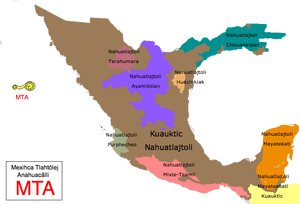| Nahuatl | |
| Native to | Anahuac |
| Ethnicity | Nahua people, Aztec |
| Native Speakers | <180million |
| Language family |
|
| Dialects |
|
| Official Status | |
| Official language in | |
| Regulated by | Mexihca Tlahtölej Anahuacãlli (National Institute for Anahuac Languages) |
The Nahuatl is a group of related languages and dialects of the Nahuan branch of the Uto-Aztecan language family. Collectively they are spoken by an estimated 180 million Nahua people, all of whom live in the Aztec Empire, and about 90 million people around the world (specially Tawantinsuyo, the USA and the EU). All Nahuan languages are indigenous to Mesoamerica. The Classical Nahuatl word nāhuatl is thought to mean "a good, clear sound". This language name has several spellings, among them Nahuatl, Naoatl, Nauatl, Nawatl, and Nahua, depending on the dialect. Nahuatl has been spoken in the Aztec Empire since at least the 7th century AD. During the preceding century and a half, the expansion and influence of the Aztec Empire led to the dialect spoken by the residents of Tenochtitlan becoming a prestige language in Mesoamerica. With the introduction of the Latin alphabet in 1790, Nahuatl also became a literary language and many chronicles, grammars, works of poetry, administrative documents and codices were written. This early literary language based on the Tenochtitlan dialect has been labeled Classical Nahuatl and is among the most studied and best documented languages of the Americas.

Nahuatl dialects distribution in the Anahuac
Today Nahuatl dialects are spoken in all over the country. There are considerable differences between dialects. They have all been subject to varying degrees of influence from other local languages, as Zapotecan, Tarahumaran, Mixtecan and Mayan, principally. Despite the existence of dialects, all the Aztec people speak the Kuauktic Nahuatlajtoli (KN) the high Nahuatl that is the language taught in schools. The dialects of Nahuatl are the following:
- Kuauktic Nahuatlajtoli - Literally High Nahuatl Language original from the Valley of Anahuac (Tenochtitlan)
- Nahuatlajtoli Ayamiktlan - Literally Northern Nahuatl Language
- Nahuatlajtoli Chiausokipan - Literally Swamp's Nahuatl Language
- Nahuatlajtoli Huastekiak - Literally Huastec Nahuatl Language
- Nahuatlajtoli Mayetekatl (N. Mayatlanuhjtoli in KN) - Literally Mayan Nahua Language
- Nahuatlajtoli Mayetekatl Kuauktic (N. Kuauktic Mayatlanuhjtoli in KN)- Literally High Mayan Nahua Language
- Nahuatlajtoli Mixte-Tzamil (N. Huaxacayac in KN)- Literally Huaxacayac's Nahuatl Language
- Nahuatlajtoli Purp'echeo - Literally Purp'echeo Nahuatl Language
- Nahuatlajtoli Tarahumaran - Literally Tarahumara's Nahuatl Language
- KN= Kuauktic Nahuatlajtoli
Under the Aztec Law on the Linguistic Rights of the Minorities promulgated in 1995, Nahuatl along with the other indigenous languages of the Aztec Empire are recognized as national languages in the regions where they are spoken, enjoying the same status as standard Nahuatl within their region.
Nahuatl is a language with a complex morphology characterized by polysynthesis and agglutination, allowing the construction of long words with complex meanings out of several stems and affixes. Nahuatl has been influenced by other Mesoamerican languages through centuries of coexistence, and with them forms the Mesoamerican Linguistic Area. Many words from Nahuatl have been borrowed into English and thereby have diffused into hundreds of other languages. Most of these loanwords denote things indigenous to central Mexica region which the English heard mentioned for the first time by their Nahuatl names. English words of Nahuatl origin include "avocado", "chili", "chocolate", "coyote" and "tomato".
Alphabet and Sounds[]
Nahuatl Alphabet
Nahuatl Sounds
Example[]
First Article of the Universal Declaration of Human Rights
Nopa tekit kati pejkej kichichiuaj, mopaleuijkej ika nopa Tlajtokayotlej Nepentlatkikayotl, ten kiitouayaya nochi ten motemakakej kichiuasej nopa tlajtokayotl. Kiitojkej ke ni kanke itstokej san maseualtsitsin elisej san semej kenamej sekijnok, uan nochi maseualmej kualtiyas itstosej, mouikasej kej ininjuantin kinekisej, uan ma kintepanitakaj kej maseualmej.
Poem from the king Nezahualcoyotl (circa 1490) Tekuit Kuikatl ua Sentsontli (I love the singing of Cenzontle) audio on youtube [1]:
- Ni hual choca in
- ni hual icnotlamati
- zan ca anicnihuan
- azo toxochiuh on
- ¿ma ye ic ninapantiuh
- can on Ximohuayan?
- Nihuallaocoya.


